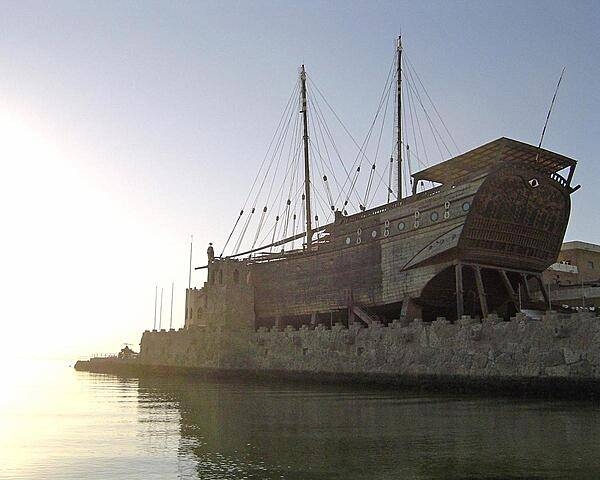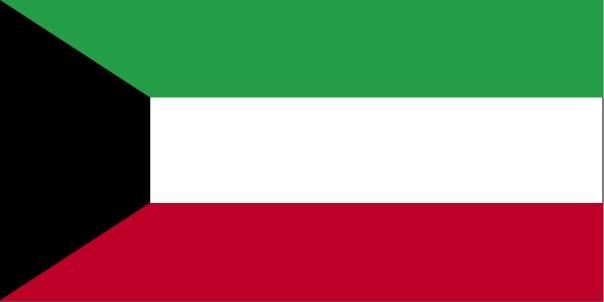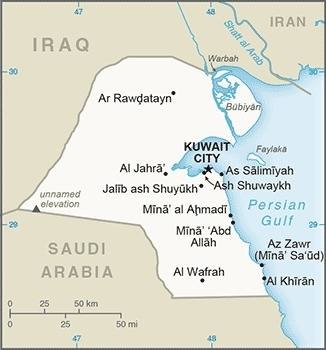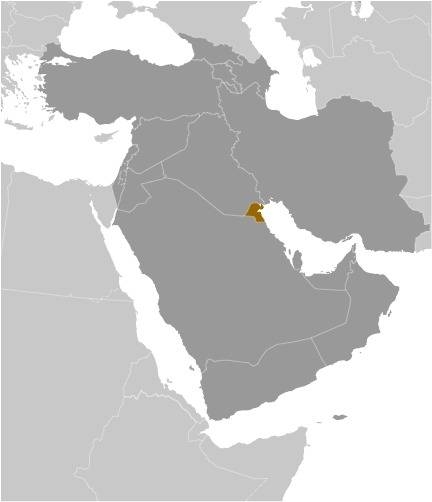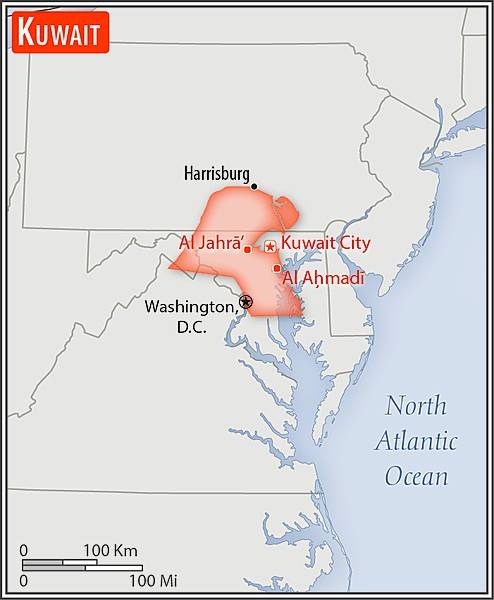Introduction
Background
Kuwait has been ruled by the AL-SABAH dynasty since the 18th century. The threat of Ottoman invasion in 1899 prompted Amir Mubarak AL-SABAH to seek protection from Britain, ceding foreign and defense responsibility to Britain until 1961, when the country attained its independence. Kuwait was attacked and overrun by Iraq in August 1990. Following several weeks of aerial bombardment, a US-led UN coalition began a ground assault in February 1991 that liberated Kuwait in four days. In 1992, the Amir reconstituted the parliament that he had dissolved in 1986. Amid the 2010-11 uprisings and protests across the Arab world, stateless Arabs, known as Bidoon, staged small protests in early 2011 demanding citizenship, jobs, and other benefits available to Kuwaiti nationals. Other demographic groups, notably Islamists and Kuwaitis from tribal backgrounds, soon joined the growing protest movements, which culminated in late 2011 with the resignation of the prime minister amidst allegations of corruption. Demonstrations renewed in late 2012 in response to an amiri decree amending the electoral law that lessened the voting power of the tribal blocs.
An opposition coalition of Sunni Islamists, tribal populists, and some liberals, largely boycotted legislative elections in 2012 and 2013, which ushered in a legislature more amenable to the government's agenda. Faced with the prospect of painful subsidy cuts, oppositionists and independents actively participated in the November 2016 election, winning nearly half of the seats, but a cohesive opposition alliance largely ceased to exist with the 2016 election and the opposition became increasingly factionalized. Since coming to power in 2006, the Amir has dissolved the National Assembly on seven occasions (the Constitutional Court annulled the Assembly elections in June 2012 and again in June 2013) and shuffled the cabinet over a dozen times, usually citing political stagnation and gridlock between the legislature and the government.
The current Amir, who assumed his role in 2020, launched a "National Dialogue" in September 2021 meant to resolve political gridlock. As part of the "National Dialogue," the Amir pardoned several opposition figures who had been living in exile, and they returned to Kuwait. Legislative challenges remain, and the cabinet was reshuffled in March 2022.
Visit the Definitions and Notes page to view a description of each topic.
Geography
Location
Middle East, bordering the Persian Gulf, between Iraq and Saudi Arabia
Geographic coordinates
29 30 N, 45 45 E
Map references
Middle East
Land boundaries
total: 475 km
border countries (2): Iraq 254 km; Saudi Arabia 221 km
Coastline
499 km
Maritime claims
territorial sea: 12 nm
Climate
dry desert; intensely hot summers; short, cool winters
Terrain
flat to slightly undulating desert plain
Elevation
highest point: 3.6 km W. of Al-Salmi Border Post 300 m
lowest point: Persian Gulf 0 m
mean elevation: 108 m
Natural resources
petroleum, fish, shrimp, natural gas
Land use
agricultural land: 8.5% (2018 est.)
arable land: 0.6% (2018 est.)
permanent crops: 0.3% (2018 est.)
permanent pasture: 7.6% (2018 est.)
forest: 0.4% (2018 est.)
other: 91.1% (2018 est.)
Irrigated land
100 sq km (2015)
Major watersheds (area sq km)
Indian Ocean drainage: (Persian Gulf) Tigris and Euphrates (918,044 sq km)
Major aquifers
Arabian Aquifer System
Population distribution
densest settlement is along the Persian Gulf, particularly in Kuwait City and on Bubiyan Island; significant population threads extend south and west along highways that radiate from the capital, particularly in the southern half of the country
Natural hazards
sudden cloudbursts are common from October to April and bring heavy rain, which can damage roads and houses; sandstorms and dust storms occur throughout the year but are most common between March and August
Geography - note
strategic location at head of Persian Gulf
People and Society
Population
3,068,155 (2022 est.)
note: Kuwait's Public Authority for Civil Information estimates the country's total population to be 4,420,110 for 2019, with non-Kuwaitis accounting for nearly 70% of the population
Nationality
noun: Kuwaiti(s)
adjective: Kuwaiti
Ethnic groups
Kuwaiti 30.4%, other Arab 27.4%, Asian 40.3%, African 1%, other 0.9% (includes European, North American, South American, and Australian) (2018 est.)
Languages
Arabic (official), English widely spoken
major-language sample(s):
كتاب حقائق العالم، المصدر الذي لا يمكن الاستغناء عنه للمعلومات الأساسية (Arabic)
The World Factbook, the indispensable source for basic information.
Religions
Muslim (official) 74.6%, Christian 18.2%, other and unspecified 7.2% (2013 est.)
note: data represent the total population; about 72% of the population consists of immigrants
Age structure
0-14 years: 24.29% (male 378,778/female 348,512)
15-24 years: 14.96% (male 245,354/female 202,642)
25-54 years: 52.39% (male 984,813/female 583,632)
55-64 years: 5.43% (male 90,583/female 72,026)
65 years and over: 2.92% (male 38,614/female 48,752) (2020 est.)
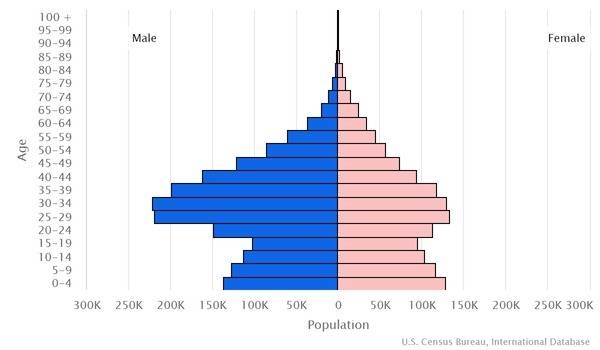
Dependency ratios
total dependency ratio: 34.4
youth dependency ratio: 28.4
elderly dependency ratio: 6
potential support ratio: 24.9 (2021 est.)
Median age
total: 29.7 years
male: 30.7 years
female: 27.9 years (2020 est.)
Population distribution
densest settlement is along the Persian Gulf, particularly in Kuwait City and on Bubiyan Island; significant population threads extend south and west along highways that radiate from the capital, particularly in the southern half of the country
Urbanization
urban population: 100% of total population (2023)
rate of urbanization: 1.35% annual rate of change (2020-25 est.)
Major urban areas - population
3.298 million KUWAIT (capital) (2023)
Sex ratio
at birth: 1.05 male(s)/female
0-14 years: 1.09 male(s)/female
15-24 years: 1.19 male(s)/female
25-54 years: 1.66 male(s)/female
55-64 years: 1.21 male(s)/female
65 years and over: 0.66 male(s)/female
total population: 1.37 male(s)/female (2022 est.)
Maternal mortality ratio
12 deaths/100,000 live births (2017 est.)
country comparison to the world: 140Infant mortality rate
total: 7.43 deaths/1,000 live births
male: 7.75 deaths/1,000 live births
female: 7.1 deaths/1,000 live births (2022 est.)
Life expectancy at birth
total population: 79.13 years
male: 77.67 years
female: 80.65 years (2022 est.)
Drinking water source
improved: urban: NA
rural: NA
total: 100% of population
unimproved: urban: NA
rural: NA
total: 0% of population (2020 est.)
Current health expenditure
5.5% of GDP (2019)
Physicians density
2.34 physicians/1,000 population (2020)
Hospital bed density
2 beds/1,000 population (2017)
Sanitation facility access
improved: urban: NA
rural: NA
total: 100% of population
unimproved: urban: NA
rural: NA
total: 0% of population (2020 est.)
Alcohol consumption per capita
total: 0 liters of pure alcohol (2019 est.)
beer: 0 liters of pure alcohol (2019 est.)
wine: 0 liters of pure alcohol (2019 est.)
spirits: 0 liters of pure alcohol (2019 est.)
other alcohols: 0 liters of pure alcohol (2019 est.)
Tobacco use
total: 17.9% (2020 est.)
male: 33.5% (2020 est.)
female: 2.2% (2020 est.)
Literacy
definition: age 15 and over can read and write
total population: 96.5%
male: 97.1%
female: 95.4% (2020)
School life expectancy (primary to tertiary education)
total: 15 years
male: 13 years
female: 16 years (2015)
Youth unemployment rate (ages 15-24)
total: 15.4%
male: 9.4%
female: 30% (2016 est.)
Environment
Environment - current issues
limited natural freshwater resources; some of world's largest and most sophisticated desalination facilities provide much of the water; air and water pollution; desertification; loss of biodiversity
Environment - international agreements
party to: Biodiversity, Climate Change, Climate Change-Kyoto Protocol, Climate Change-Paris Agreement, Comprehensive Nuclear Test Ban, Desertification, Endangered Species, Environmental Modification, Hazardous Wastes, Law of the Sea, Nuclear Test Ban, Ozone Layer Protection, Ship Pollution, Wetlands
signed, but not ratified: Marine Dumping-London Convention
Air pollutants
particulate matter emissions: 57.17 micrograms per cubic meter (2016 est.)
carbon dioxide emissions: 98.73 megatons (2016 est.)
methane emissions: 6.21 megatons (2020 est.)
Climate
dry desert; intensely hot summers; short, cool winters
Land use
agricultural land: 8.5% (2018 est.)
arable land: 0.6% (2018 est.)
permanent crops: 0.3% (2018 est.)
permanent pasture: 7.6% (2018 est.)
forest: 0.4% (2018 est.)
other: 91.1% (2018 est.)
Urbanization
urban population: 100% of total population (2023)
rate of urbanization: 1.35% annual rate of change (2020-25 est.)
Revenue from forest resources
forest revenues: 0% of GDP (2018 est.)
country comparison to the world: 179Waste and recycling
municipal solid waste generated annually: 1.75 million tons (2010 est.)
Major watersheds (area sq km)
Indian Ocean drainage: (Persian Gulf) Tigris and Euphrates (918,044 sq km)
Major aquifers
Arabian Aquifer System
Total water withdrawal
municipal: 448.3 million cubic meters (2017 est.)
industrial: 23.3 million cubic meters (2017 est.)
agricultural: 778.4 million cubic meters (2017 est.)
Total renewable water resources
20 million cubic meters (2017 est.)
Government
Country name
conventional long form: State of Kuwait
conventional short form: Kuwait
local long form: Dawlat al Kuwayt
local short form: Al Kuwayt
etymology: the name derives from the capital city, which is from Arabic "al-Kuwayt" a diminutive of "kut" meaning "fortress," possibly a reference to a small castle built on the current location of Kuwait City by the Beni Khaled tribe in the 17th century
Government type
constitutional monarchy (emirate)
Capital
name: Kuwait City
geographic coordinates: 29 22 N, 47 58 E
time difference: UTC+3 (8 hours ahead of Washington, DC, during Standard Time)
etymology: the name derives from Arabic "al-Kuwayt" a diminutive of "kut" meaning "fortress," possibly a reference to a small castle built on the current location of Kuwait City by the Beni Khaled tribe in the 17th century
Administrative divisions
6 governorates (muhafazat, singular - muhafazah); Al Ahmadi, Al 'Asimah, Al Farwaniyah, Al Jahra', Hawalli, Mubarak al Kabir
Independence
19 June 1961 (from the UK)
National holiday
National Day, 25 February (1950)
Constitution
history: approved and promulgated 11 November 1962; suspended 1976 to 1981 (4 articles); 1986 to 1991; May to July 1999
amendments: proposed by the amir or supported by at least one third of the National Assembly; passage requires two-thirds consent of the Assembly membership and promulgation by the amir; constitutional articles on the initiation, approval, and promulgation of general legislation cannot be amended
Legal system
mixed legal system consisting of English common law, French civil law, and Islamic sharia law
International law organization participation
has not submitted an ICJ jurisdiction declaration; non-party state to the ICCt
Citizenship
citizenship by birth: no
citizenship by descent only: at least one parent must be a citizen of Kuwait
dual citizenship recognized: no
residency requirement for naturalization: not specified
Suffrage
21 years of age and at least 20-year citizenship
Executive branch
chief of state: Ahmad al-NAWAF al-Sabah (since 24 July 2022); Crown Prince Mishal al-AHMAD al-Sabah, born in 1940, is the brother of Amir Nawaf al-AHMAD al-Jabir al-Sabah
head of government: Prime Minister Sheikh Muhammad al-Sabah al-SALIM al-Sabah (since 19 July 2022); First Deputy Prime Minister and Minister of Interior Sheikh Ahmed al-NAWAF al-Sabah (since 22 March 2022), Deputy Prime Minister and Minister of Defense Sheikh Talal al-KHALID al-Sabah (since 1 August 2022), and Deputy Prime Minister and Minister of Oil and Minister of State for Cabinet Affairs Dr. Mohammed al-FARIS (since 22 March 2022)
cabinet: Council of Ministers appointed by the prime minister, approved by the amir
elections/appointments: amir chosen from within the ruling family, confirmed by the National Assembly; prime minister and deputy prime ministers appointed by the amir; crown prince appointed by the amir and approved by the National Assembly
Legislative branch
description: unicameral National Assembly or Majlis al-Umma (65 seats; 50 members directly elected from 5 multi-seat constituencies by simple majority vote and 15 ex-officio members (cabinet ministers) appointed by the amir; members serve 4-year terms)
elections: last held on 29 September 2022 (next to be held in 2026)
election results: 50 nonpartisans elected, of which 28 were opposition candidates; composition - men 48, women 2, percent of women 4%
Judicial branch
highest court(s): Constitutional Court (consists of 5 judges); Supreme Court or Court of Cassation (organized into several circuits, each with 5 judges)
judge selection and term of office: all Kuwaiti judges appointed by the Amir upon recommendation of the Supreme Judicial Council, a consultative body comprised of Kuwaiti judges and Ministry of Justice officials
subordinate courts: High Court of Appeal; Court of First Instance; Summary Court
Political parties and leaders
none; the government does not recognize any political parties or allow their formation, although no formal law bans political parties
International organization participation
ABEDA, AfDB (nonregional member), AFESD, AMF, BDEAC, CAEU, CD, FAO, G-77, GCC, IAEA, IBRD, ICAO, ICC (national committees), ICRM, IDA, IDB, IFAD, IFC, IFRCS, IHO, ILO, IMF, IMO, IMSO, Interpol, IOC, IPU, ISO, ITSO, ITU, ITUC (NGOs), LAS, MIGA, NAM, OAPEC, OIC, OPCW, OPEC, Paris Club (associate), PCA, UN, UNCTAD, UNESCO, UNIDO, UNRWA, UN Security Council (temporary), UNWTO, UPU, WCO, WFTU (NGOs), WHO, WIPO, WMO, WTO
Diplomatic representation in the US
chief of mission: Ambassador SALEM Abdallah al-Jaber al-Sabah (since 10 October 2021)
chancery: 2940 Tilden Street NW, Washington, DC 20008
telephone: [1] (202) 966-0702
FAX: [1] (202) 966-8468
email address and website:
https://www.kuwaitembassy.us/
consulate(s) general: Beverly Hills (CA), New York
Diplomatic representation from the US
chief of mission: Ambassador (vacant); Chargé d’Affaires James HOLTSNIDER (since July 2021)
embassy: P.O. Box 77, Safat 13001
mailing address: 6200 Kuwait Place, Washington DC 20521-6200
telephone: [00] (965) 2259-1001
FAX: [00] (965) 2538-0282
email address and website:
KuwaitACS@state.gov
https://kw.usembassy.gov/
Flag description
three equal horizontal bands of green (top), white, and red with a black trapezoid based on the hoist side; colors and design are based on the Arab Revolt flag of World War I; green represents fertile fields, white stands for purity, red denotes blood on Kuwaiti swords, black signifies the defeat of the enemy
National symbol(s)
golden falcon; national colors: green, white, red, black
National anthem
name: "Al-Nasheed Al-Watani" (National Anthem)
lyrics/music: Ahmad MUSHARI al-Adwani/Ibrahim Nasir al-SOULA
note: adopted 1978; the anthem is only used on formal occasions
Economy
Economic overview
Kuwait has a geographically small, but wealthy, relatively open economy with crude oil reserves of about 102 billion barrels - more than 6% of world reserves. Kuwaiti officials plan to increase production to 4 million barrels of oil equivalent per day by 2020. Petroleum accounts for over half of GDP, 92% of export revenues, and 90% of government income.
With world oil prices declining, Kuwait realized a budget deficit in 2015 for the first time more than a decade; in 2016, the deficit grew to 16.5% of GDP. Kuwaiti authorities announced cuts to fuel subsidies in August 2016, provoking outrage among the public and National Assembly, and the Amir dissolved the government for the seventh time in ten years. In 2017 the deficit was reduced to 7.2% of GDP, and the government raised $8 billion by issuing international bonds. Despite Kuwait’s dependence on oil, the government has cushioned itself against the impact of lower oil prices, by saving annually at least 10% of government revenue in the Fund for Future Generations.
Kuwait has failed to diversify its economy or bolster the private sector, because of a poor business climate, a large public sector that employs about 74% of citizens, and an acrimonious relationship between the National Assembly and the executive branch that has stymied most economic reforms. The Kuwaiti Government has made little progress on its long-term economic development plan first passed in 2010. While the government planned to spend up to $104 billion over four years to diversify the economy, attract more investment, and boost private sector participation in the economy, many of the projects did not materialize because of an uncertain political situation or delays in awarding contracts. To increase non-oil revenues, the Kuwaiti Government in August 2017 approved draft bills supporting a Gulf Cooperation Council-wide value added tax scheduled to take effect in 2018.
Real GDP (purchasing power parity)
$209.74 billion (2019 est.)
$208.85 billion (2018 est.)
$206.274 billion (2017 est.)
note: data are in 2017 dollars
Real GDP growth rate
-3.3% (2017 est.)
2.2% (2016 est.)
-1% (2015 est.)
Real GDP per capita
$49,900 (2019 est.) note: data are in 2017 dollars
$50,500 (2018 est.) note: data are in 2017 dollars
$50,856 (2017 est.)
GDP (official exchange rate)
$134.638 billion (2019 est.)
Credit ratings
Fitch rating: AA (2008)
Moody's rating: A1 (2020)
Standard & Poors rating: AA- (2020)
note: The year refers to the year in which the current credit rating was first obtained.
GDP - composition, by sector of origin
agriculture: 0.4% (2017 est.)
industry: 58.7% (2017 est.)
services: 40.9% (2017 est.)
GDP - composition, by end use
household consumption: 43.1% (2017 est.)
government consumption: 24.5% (2017 est.)
investment in fixed capital: 26.5% (2017 est.)
investment in inventories: 3.5% (2017 est.)
exports of goods and services: 49.4% (2017 est.)
imports of goods and services: -47% (2017 est.)
Agricultural products
eggs, dates, tomatoes, cucumbers, poultry, milk, mutton, potatoes, vegetables, eggplants
Industries
petroleum, petrochemicals, cement, shipbuilding and repair, water desalination, food processing, construction materials
Labor force
2.695 million (2017 est.)
note: non-Kuwaitis represent about 60% of the labor force
Labor force - by occupation
agriculture: NA
industry: NA
services: NA
Youth unemployment rate (ages 15-24)
total: 15.4%
male: 9.4%
female: 30% (2016 est.)
Household income or consumption by percentage share
lowest 10%: NA
highest 10%: NA
Budget
revenues: 50.5 billion (2017 est.)
expenditures: 62.6 billion (2017 est.)
Fiscal year
1 April - 31 March
Current account balance
$7.127 billion (2017 est.)
-$5.056 billion (2016 est.)
Exports
$72.83 billion (2019 est.) note: data are in current year dollars
$85.2 billion (2018 est.) note: data are in current year dollars
Exports - partners
China 20%, South Korea 16%, India 15%, Japan 10%, Taiwan 6%, Vietnam 5% (2019)
Exports - commodities
crude petroleum, refined petroleum, aircraft, natural gas, industrial hydrocarbon products (2019)
Imports
$59.65 billion (2019 est.) note: data are in current year dollars
$68.2 billion (2018 est.) note: data are in current year dollars
Imports - partners
China 14%, United Arab Emirates 12%, United States 10%, Saudi Arabia 6%, Japan 6%, Germany 5%, India 5% (2019)
Imports - commodities
cars, broadcasting equipment, natural gas, packaged medicines, jewelry (2019)
Reserves of foreign exchange and gold
$33.7 billion (31 December 2017 est.)
$31.13 billion (31 December 2016 est.)
Debt - external
$47.24 billion (31 December 2017 est.)
$38.34 billion (31 December 2016 est.)
Exchange rates
Kuwaiti dinars (KD) per US dollar -
0.3049 (2020 est.)
0.3037 (2019 est.)
0.304 (2018 est.)
0.3009 (2014 est.)
0.2845 (2013 est.)
Energy
Electricity access
electrification - total population: 100% (2020)
Electricity
installed generating capacity: 19.371 million kW (2020 est.)
consumption: 63,802,360,000 kWh (2019 est.)
exports: 0 kWh (2019 est.)
imports: 0 kWh (2019 est.)
transmission/distribution losses: 6.701 billion kWh (2019 est.)
Electricity generation sources
fossil fuels: 99.9% of total installed capacity (2020 est.)
nuclear: 0% of total installed capacity (2020 est.)
solar: 0% of total installed capacity (2020 est.)
wind: 0.1% of total installed capacity (2020 est.)
hydroelectricity: 0% of total installed capacity (2020 est.)
tide and wave: 0% of total installed capacity (2020 est.)
geothermal: 0% of total installed capacity (2020 est.)
biomass and waste: 0% of total installed capacity (2020 est.)
Coal
production: 0 metric tons (2020 est.)
consumption: 68,000 metric tons (2020 est.)
exports: 0 metric tons (2020 est.)
imports: 68,000 metric tons (2020 est.)
proven reserves: 0 metric tons (2019 est.)
Petroleum
total petroleum production: 2,720,500 bbl/day (2021 est.)
refined petroleum consumption: 342,000 bbl/day (2019 est.)
crude oil and lease condensate exports: 1,837,900 bbl/day (2018 est.)
crude oil and lease condensate imports: 0 bbl/day (2018 est.)
crude oil estimated reserves: 101.5 billion barrels (2021 est.)
Refined petroleum products - production
915,800 bbl/day (2015 est.)
country comparison to the world: 22Natural gas
production: 19,509,907,000 cubic meters (2019 est.)
consumption: 24,322,970,000 cubic meters (2019 est.)
exports: 0 cubic meters (2021 est.)
imports: 4,805,531,000 cubic meters (2019 est.)
proven reserves: 1,783,958,000,000 cubic meters (2021 est.)
Carbon dioxide emissions
92.582 million metric tonnes of CO2 (2019 est.)
from coal and metallurgical coke: 578,000 metric tonnes of CO2 (2019 est.)
from petroleum and other liquids: 44.288 million metric tonnes of CO2 (2019 est.)
from consumed natural gas: 47.715 million metric tonnes of CO2 (2019 est.)
Energy consumption per capita
381.985 million Btu/person (2019 est.)
country comparison to the world: 7Communications
Telephones - fixed lines
total subscriptions: 583,463 (2020 est.)
subscriptions per 100 inhabitants: 14 (2020 est.)
Telephones - mobile cellular
total subscriptions: 6,770,346 (2020 est.)
subscriptions per 100 inhabitants: 159 (2020 est.)
Telecommunication systems
general assessment: Kuwait’s telecom infrastructure is well developed, with a focus on mobile infrastructure and services; the telecom sector is important to the country’s economy, and this will become more pronounced in coming years as the economy is purposefully transitioned away from a dependence on oil and gas to one which is increasingly knowledge-based and focused on ICT and related services; the MNOs have focused investment on 5G networks, which support and promote the growth of data traffic; this in turn has been a catalyst for revenue growth in recent quarters; while Kuwait’s mobile sector shows considerable progress; the country’s fixed broadband system is the lowest in the region; the government has stepped up efforts to build up fixed broadband networks, and ultimately this sector offers a potential future growth opportunity; improvements to the fixed broadband infrastructure will help develop sectors such as e-commerce, along with smart infrastructure developments, and tech start-ups (2022)
domestic: fixed-line subscriptions are nearly 14 per 100 and mobile-cellular stands at nearly 159 per 100 subscriptions (2020)
international: country code - 965; landing points for the FOG, GBICS, MENA, Kuwait-Iran, and FALCON submarine cables linking Africa, the Middle East, and Asia; microwave radio relay to Saudi Arabia; satellite earth stations - 6 (3 Intelsat - 1 Atlantic Ocean and 2 Indian Ocean, 1 Inmarsat - Atlantic Ocean, and 2 Arabsat) (2019)
note: the COVID-19 pandemic continues to have a significant impact on production and supply chains globally; since 2020, some aspects of the telecom sector have experienced a downturn, particularly in mobile device production; progress toward 5G implementation has resumed, as well as upgrades to infrastructure; consumer spending on telecom services has increased due to the surge in demand for capacity and bandwidth; the crucial nature of telecom services as a tool for work and school from home is still evident, and the spike in this area has seen growth opportunities for development of new tools and increased services
Broadcast media
state-owned TV broadcaster operates 4 networks and a satellite channel; several private TV broadcasters have emerged; satellite TV available and pan-Arab TV stations are especially popular; state-owned Radio Kuwait broadcasts on a number of channels in Arabic and English; first private radio station emerged in 2005; transmissions of at least 2 international radio broadcasters are available (2019)
Internet users
total: 4,227,857 (2020 est.)
percent of population: 99% (2020 est.)
Broadband - fixed subscriptions
total: 73,948 (2020 est.)
subscriptions per 100 inhabitants: 2 (2020 est.)
Transportation
National air transport system
number of registered air carriers: 2 (2020)
inventory of registered aircraft operated by air carriers: 44
annual passenger traffic on registered air carriers: 6,464,847 (2018)
annual freight traffic on registered air carriers: 392.36 million (2018) mt-km
Airports - with paved runways
total: 4
over 3,047 m: 1
2,438 to 3,047 m: 2
914 to 1,523 m: 1 (2021)
Airports - with unpaved runways
total: 3
1,524 to 2,437 m: 1
under 914 m: 2 (2021)
Heliports
4 (2021)
Pipelines
261 km gas, 540 km oil, 57 km refined products (2013)
Roadways
total: 5,749 km (2018)
paved: 4,887 km (2018)
unpaved: 862 km (2018)
Merchant marine
total: 165
by type: general cargo 15, oil tanker 28, other 122 (2021)
Ports and terminals
major seaport(s): Ash Shu'aybah, Ash Shuwaykh, Az Zawr (Mina' Sa'ud), Mina' 'Abd Allah, Mina' al Ahmadi
Military and Security
Military and security forces
Kuwaiti Armed Forces (KAF): Kuwaiti Land Forces (KLF), Kuwaiti Navy, Kuwaiti Air Force (Al-Quwwat al-Jawwiya al-Kuwaitiya; includes Kuwaiti Air Defense Force, KADF), 25th Commando Brigade, and the Kuwait Emiri Guard Brigade; Kuwaiti National Guard (KNG); Coast Guard (Ministry of Interior) (2022)
note 1: the Kuwait Amiri Guard Authority and the 25th Commando Brigade exercise independent command authority within the Kuwaiti Armed Forces, although activities such as training and equipment procurement are often coordinated with the other services
note 2: the Kuwaiti National Guard reports directly to the prime minister and the amir and possesses an independent command structure, equipment inventory, and logistics corps separate from the Ministry of Defense, the regular armed services, and the Ministry of Interior; it is responsible for protecting critical infrastructure and providing support for the Ministries of Interior and Defense as required
Military expenditures
6.8% of GDP (2021 est.)
6.3% of GDP (2020 est.)
5.6% of GDP (2019) (approximately $10.2 billion)
5.1% of GDP (2018) (approximately $9.25 billion)
5.6% of GDP (2017) (approximately $10 billion)
Military and security service personnel strengths
approximately 17,000 active duty armed forces personnel (12,500 Army, including the Amiri Guard and 25th Commando Brigade; 2,000 Navy; 2,500 Air Force); approximately 6,500 National Guard (2022)
Military equipment inventories and acquisitions
the military's inventory consists of weapons from a wide variety of sources, including Western Europe, Russia, the United Arab Emirates, and the US; the US has been the leading supplier of arms to Kuwait since 2010 (2022)
Military service age and obligation
18-26 years of age for voluntary military service; Kuwait reintroduced 12-month mandatory service for men aged 18-35 in May 2017 after having suspended conscription in 2001; mandatory service is divided in two phases – 4 months for training and 8 months for military service; women were allowed to volunteer in 2021 (2022)
note: the National Guard is restricted to citizens, but in 2018, the Army began allowing non-Kuwaitis to join on contract or as non-commissioned officers; that same year, it also began allowing stateless people (Bidoon) to join
Military - note
as of 2022, the US had approximately 13,000 military personnel based in Kuwait as part of a 1991 Defense Cooperation Agreement and a 2013 Acquisition and Cross-Servicing Agreement
Kuwait has Major Non-NATO Ally (MNNA) status with the US; MNNA is a designation under US law that provides foreign partners with certain benefits in the areas of defense trade and security cooperation; while MNNA status provides military and economic privileges, it does not entail any security commitments (2022)
Transnational Issues
Disputes - international
Kuwait-Iraq: no maritime boundary exists with Iraq in the Persian Gulf
Kuwait-Saudi Arabia: their maritime boundary was established in 2000 and has a neutral zone but its extension to Iran’s maritime boundary has not been negotiated
Refugees and internally displaced persons
stateless persons: 92,020 (mid-year 2021); note - Kuwait's 1959 Nationality Law defined citizens as persons who settled in the country before 1920 and who had maintained normal residence since then; one-third of the population, descendants of Bedouin tribes, missed the window of opportunity to register for nationality rights after Kuwait became independent in 1961 and were classified as bidun (meaning "without"); since the 1980s Kuwait's bidun have progressively lost their rights, including opportunities for employment and education, amid official claims that they are nationals of other countries who have destroyed their identification documents in hopes of gaining Kuwaiti citizenship; Kuwaiti authorities have delayed processing citizenship applications and labeled biduns as "illegal residents," denying them access to civil documentation, such as birth and marriage certificates
